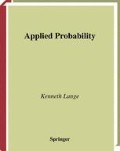Abstract
Genetic identity coefficients are powerful theoretical tools for genetic analysis. Geneticists have devised these indices to measure the degree of inbreeding of a single individual and the degree of relatedness of a pair of relatives. Since the degree of inbreeding of a single individual can be summarized by the relationship between his or her parents, we will focus on identity coefficients for relative pairs. These coefficients pertain to a generic autosomal locus and depend only on the relevant pedigree connecting two relatives and not on any phenotypes observed in the pedigree. In Chapter 6 we will investigate the applications of identity coefficients. Readers desiring motivation for the combinatorial problems attacked here may want to glance at Chapter 6 first.
Access this chapter
Tax calculation will be finalised at checkout
Purchases are for personal use only
Preview
Unable to display preview. Download preview PDF.
5.8 References
Cotterman CW (1940) A Calculus for Statistico-Genetics. Ph.D. thesis, Ohio State University, in Genetics and Social Structure: Mathematical Structuralism in Population Genetics and Social Theory. (1974) Ballonoff PA, editor, Dowden, Hutchinson & Ross, Stroudsburg, PA, pp 155–272
Gillois M (1964) La relation d’identité en génétique. Ann Inst Henri Poincaré B 2:1–94
Harris DL (1964) Genotypic covariances between inbred relatives. Genetics 50:1319–1348
Henderson CR (1976) A simple method for computing the inverse of the numerator relationship matrix used in prediction of breeding values. Biometrics 32:69–83
Jacquard A (1966) Logique du calcul des coefficients d’identité entre deux individus. Population (Paris) 21:751–776
Jacquard A (1974) The Genetic Structure of Populations. Springer-Verlag, New York
Karigl G (1981) A recursive algorithm for the calculation of identity coefficients. Ann Hum Genet 45:299–305
Karigl G (1982) Multiple genetic relationships: joint and conditional genotype probabilities. Ann Hum Genet 46:83–92
Lange K, Sinsheimer JS (1992) Calculation of genetic identity coefficients. Ann Hum Genet 56:339–346
Lange K, Westlake J, Spence MA (1976) Extensions to pedigree analysis. II. Recurrence risk calculation under the polygenic threshold model. Hum Hered 26:337–348
Lange K, Westlake J, Spence MA (1976) Extensions to pedigree analysis. III. Variance components by the scoring method. Ann Hum Genet 39:485–491
Malécot G (1948) Les Mathématiques de I’Hérédité. Masson et Cie, Paris
Nadot R, Vaysseix G (1973) Apparentement et identityé. Algorithme du calcul des coefficients d’identité, Biometrics 29:347–359
Thompson EA (1983) Gene extinction and allelic origins in complex genealogies. Proc R Soc London B 219:241–251
Thompson EA (1986) Pedigree Analysis in Human Genetics. Johns Hopkins University Press, Baltimore
Thompson EA, Shaw RG (1990) Pedigree analysis for quantitative traits: Variance components without matrix inversion. Biometrics 46:399–413
Weeks DE, Lange K (1988) The affected-pedigree-member method of linkage analysis. Amer J Hum Genet 42:315–326
Weeks DE, Valappil TI, Schroeder M, Brown DL (1995) An X-linked version of the affected pedigree member method of linkage analysis. Hum Hered 45:25–33
Rights and permissions
Copyright information
© 2003 Springer-Verlag New York, Inc.
About this chapter
Cite this chapter
(2003). Genetic Identity Coefficients. In: Applied Probability. Springer Texts in Statistics. Springer, New York, NY. https://doi.org/10.1007/978-0-387-22711-5_5
Download citation
DOI: https://doi.org/10.1007/978-0-387-22711-5_5
Publisher Name: Springer, New York, NY
Print ISBN: 978-0-387-00425-9
Online ISBN: 978-0-387-22711-5
eBook Packages: Springer Book Archive

